September 21st, 2010 · 1 Comment
We have talked a lot about the accessibility of beauty and the arts in London. Free museums, buskers in the tube stations, art on the walls of the tube stations, well-kept public parks and green spaces, free concerts, and, finally, affordable, professional theatre. In the U.S., quality theatrical performances are reserved for the middle-ish and upper classes because of the high cost of tickets. In the UK, much of the arts are subsidized by the government, so even big productions in the West End attract an audience of diverse financial means. Here in London, it is not uncommon for students and other last-minute types to pick up tickets for 15 or 20 quid. In my four weeks in London I have seen four plays, what would have amounted to at least a hundred dollars in ticket prices in the states. It feels so much more elevated that our default entertainment is the theatre instead of the movies. I can’t speak for everyone, but I would take Les Mis over The Expendables any day.
I have been fortunate enough to attend a number of performances over the years in the U.S. including theatre, ballet, opera, concerts, etc., but always as a special treat, a luxury. In London, the arts can be a regular part of your life regardless of income, and I think that is possibly the best thing about this city. As fun as dressing up for a special night out and having a fancy dinner can be, I’m even more satisfied in jeans and a sandwich from Pret if it means I can go to the theatre on a regular basis.
Each of the plays we saw as a class were very different from one another so it’s hard to pick a favorite. We saw Shakespeare (The Merry Wives of Windsor), a comedy (The 39 Steps), and a somewhat experimental drama (The Habit of Art), outside of class I saw a musical (Les Mis).
I wonder, with increased accessibility, (and therefore increased exposure?) to the arts, do more people choose to pursue the arts as a career in the UK than in the U.S. or other parts of the world? Does England have a higher percentage of the population working as actors, artists, or musicians? Thoughts?
Tags: 2010 Rachel
September 21st, 2010 · 1 Comment
Theatres:
While in London, the thing I’ve been most excited about but under-utilized the most is the theatre. As we’ve all realized, there are terrific opportunities in London to see world-class theatre for reasonable prices. With tickets at the Globe for 5 pounds and many West End plays discounted from 70 to around 20 pounds just for students, even those on a student’s budget can afford to see a play every week or two. The globe is one of the most important sites in the history of theatre. The West End is home of some of the best drama and musical theatre being produced anywhere in the world. I love to see shows back home in D.C. but the prices are often prohibitively expensive. It would have been nice to see more theatre in London but I guess that just means I’ll have to come back.
During the past four weeks I saw two plays at the globe: The Merry Wives of Windsor and the terrible, terrible play, Bedlam. I was so impressed by the Merry Wives cast and even the staging was an impressive feat in such an old-fashioned theatre. I felt that flow of drama which really brings you to suspend your disbelief and become totally lost in a production. I love that feeling. I spent the entirety of Bedlam, however, trying to figure out what anyone behind the play or on the stage was trying to do. At the end of the first act the actors almost got into enough a groove to be believable but at the start of the second act they had slipped out of the authenticity of their performance and the entire play felt forced.
In addition, Bedlam was so full of plot wholes that we thought it must be missing scenes. It was certainly missing those scenes and points in a production when the narrative is woven together into a cohesive whole. On top of all this, the female writer of the script (the first play written by a female to be performed in the Globe) was attempting to achieve a period piece in a theatre famous for Shakespearian productions. The very idea of attempting this is befuddling. As we left the theatre that night, the only thing we could say we’d gotten out of Bedlam was material for jokes. And even those weren’t that good: “It certainly was BEDLAM!”… ha… ha…
On the opposite end of the spectrum I saw Les Mis. I’ve seen it before, at the Signature theatre in Arlington, VA but there’s nothing quite like seeing the incredibly well-done production on a revolving stage. Through their use of what amounts to a giant turntable, the director of Les Mis. was able to expand the stage and create an illusion of passing space and time. I was really impressed and entertained by this production, the songs from which we’ve still not managed to get out of our heads.
I also really enjoyed The 39 Steps, the Monty Python-style physical comedy we saw. It didn’t have the depth of narrative I usually like but it was endlessly entertaining to watch. If there’s one thing I have to come back to London for, it’s to see great theatre for cheap. I plan to come back when I can from Norwich and visit London throughout my life for this purpose.
Tags: 2010 Daniel
September 21st, 2010 · No Comments
I’ve been trying very hard not to compare London with New York, and failing miserably. But I think that this is one topic on which I may be excused – Broadway vs. West End. As a native New Yorker, and someone fortunate enough to have seen a number of Broadway shows, I must admit to a certain bias. However, almost all of the shows that I have seen in London have been wonderful productions. The Merry Wives of Windsor at Shakespeare’s Globe, though painful due to standing for two hours, was definitely a unique experience. You can’t get quite the same feel in the states – it doesn’t feel as genuine. Les Misérables and 39 Steps were also very well done, offering two of my favorite things – music and comedy. I even enjoyed The Habit of Art, a more serious drama than I am usually partial to. Not only were each of the productions well executed technically, but I thought the actual acting, the conveying of emotion was phenomenal.
However, not every performance I attended left me with the same impression, and I’m afraid that one really bad experience has tipped the scale in Broadway’s favor. I think almost everyone in our program has heard of the great theatre debacle by now. If you haven’t, here’s a quick rundown: Mel, Dan and I went to see a show in the West End. I cannot reveal which show because we all decided that it was just too horrible to mention by name ever again. However, I can describe what was so terribly bad about it. Perhaps what I found most frustrating was that the show had such potential. The plotline allowed for many opportunities of real dance numbers. Instead we got the same exact choreography again and again, song after song. Usually in a musical, dance numbers also have singing. Again we were disappointed. Most, if not all of the songs were played from a soundtrack with the performers occasionally singing some obnoxiously loud misplaced note. And now we discuss the acting. To be fair, they really didn’t have much to work with, but even a high school student could have done a better job of conveying emotion. I suppose there was attempted humor, but the jokes were not funny and even if they had been, the lines were delivered without much enthusiasm.
Tags: 2010 Sarah
September 21st, 2010 · 1 Comment
There’s a crazy wide variety of theatres in London, more than I’ve ever experienced in one place before. Sure, it’s a little bit annoying to stand up for 3 hours while watching a play, but when am I going to have the experience to lean on the stage of a theatre, except when I’m at the Globe? And when am I going to get to see big name shows like Les Mis and Wicked one night and brand new shows like Deathtrap and Bedlam the next?
Theatre is so different here than in the US. In the States, theatre is very elitist. Tickets are so expensive that it’s hard for the medium to be accessible to everyone. Here, because the tickets are cheaper, it’s much easier for everyone to go out to the theatre much more frequently. We showed up yesterday morning and got 25 pound front row seats for Deathtrap. We were so close we could see Jonathon Groff spit (although I’m fairly certain everyone could see that). Because people can get such cheap tickets so frequently, many people- of many different social and economic backgrounds- are all so accustomed to going to the theatre. This results in the delightful traditions we witnessed at places like the Royal Albert Hall; symphony-goers starting a slow clap during intermission and coughing loudly between movements and the like.
To read a little more about these traditions, check out this site: http://www.independent.co.uk/arts-entertainment/classical/features/how-the-proms-turned-populist-without-offending-the-purists-2040031.html.
Part of the reason that theatre here is so accessible is that the UK makes an effort to get people out to the theatre. Right now there is program running called A Night Less Ordinary, which offers free tickets for over 200 of the subsidized theatres in England to residents under the age of 26 (http://www.ukstudentlife.com/Life/Entertainment/Theatre/Tickets.htm). It’s amazing to me that the government would offer free theatre tickets. In the states, that would be unheard of.
Here, theatre is a bit of an equalizer. A college student like myself can pay 15 pounds (or, in our case, have the school pay our 15 pounds) to go to the National Theatre and sit 10 seats away from Sir Ian McKellen (true story, folks)! And if you don’t mind sitting in the back row of the Apollo Victoria or the Barbican, you’ll end up paying as much as you might pay for a mediocre dinner to go see a West End show.
The accessibility of the theatre seems to foster a love of the theatre in this country. To me, government subsidized tickets for young people make perfect sense. Get ‘em hooked, and they’ll keep coming back for more, something that is apparent when you look at the audiences here. Every show is practically packed, at shows that have been running for 2 months and ones that have been running for 20 years.
And, did I mention how fun it is to meet the actors after the low-priced performances?:

Not too shabby, eh?
Tags: 2010 Jessica
September 20th, 2010 · 1 Comment
Back home it never sounded appealing or entertaining to me to see people run around in less than a 30ft area singing and jumping. Much less did I find the price tags of theater plays appealing, with prices generally starting at $100. Therefore, it is safe to assume that beyond school functions I had never seen a professional theater play in America.
That all changed, however, the minute I landed in London. In England people generally value art and the art of performance itself a lot more than in the United States. In the United States for example a performance always has to be entertaining above all this I feel has lowered the quality of shows. In England the people will continually go see a play even if the ending does not leave you with that warm fuzzy feeling and example of which is Billy Elliot.
My experience with plays here in London began with none other than William Shakespeare’s the Merry Wives of Windsor. It was a very good production, but it did not leave me with a feeling of must go see more plays. My second experience was Les Miserables. This show was not a required viewing by my professor but instead I decided to go with a large group of people from my program. I have always heard such good things about Les Miserables I had to just go see it. What a good decision that was. For only £15 or ($22) I not only got one of the best vocal performances I have ever seen, but I was given a political message throughout the storyline. In just 30 ft of limited space a group of 25 people were able to show me all of that. I was sold on the idea of theatre; I finally understand it and am now so willing to go to more. To this point in time Les Miserables is my favorite play.
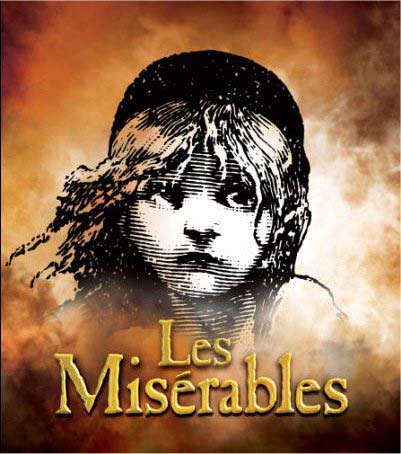
After this show the group switched gears and went to see a show called 39 Steps; which although it was set in the time period leading up to World War II it turned out to be a comedy. The cast of this show was only a whopping 4 people. Props were limited and the space even smaller than before. These people, however, were able to not only make me laugh but make it seem that they had gone to the country side, on a train, in a manor, and in an apartment. It was amazing, the creativity of such a production. The last show we have seen was The Habit of Art, this show like the one before was also a comedy. The organization of the show was a play within a play, like a behind the scenes movie. The messages from the show and social commentary were surprisingly dead on with what I believe. If there is one thing these shows have taught me is to definitely be willing to go to performances that are little known because sometimes they will be some the best times you’ll have.

The last aspect I noted in all these viewings was the type of audience they all have. Unlike America since the price of shows in London are significantly more accessible the class range of people who attend is astronomically different than back home. I also saw more of the younger generations attend shows here rather than the typical Grandma taking their kids to the show. The only type of people I didn’t notice, which could have been a result of bad observations on my part, was people of non-british backgrounds.
Overall my experience with the theatre in London has been extremely positive and I only look forward to expand my horizons by possibly going to see Operas like La Boheme.
Tags: 2010 Jamie
September 19th, 2010 · 1 Comment
I have now seen a total of five shows here in London. First, the Merry Wives of Windsor at the Globe Theatre, followed by the Czech Philharmonic concert at Royal Albert Hall, Les Miserables at the Queen’s Theatre, The 39 Steps at the Criterion Theatre, and The Habit of Art at the National Theatre. For this blog post, I will focus on The 39 Steps and The Habit of Art, because I think these shows have certain things in common that are a good demonstration of British culture.
Both shows were distinctly meta-theatrical. In The 39 Steps, costume and set changes happened right on stage and Professor Jordan proclaims the show’s self-consciousness when he is shot by a bodiless arm at the end of the show and shouts “This is supposed to be a four person cast!” The Habit of Art is a play within a play. Better yet, the play within the play is being rehearsed at the National Theatre, where the play is being shown. The rehearsal of Caliban’s Day is frequently interrupted by the actors, the stage manager, and the writer to talk about the trials and tribulations of acting, writing, and theatre. I think that both of these shows’ use of meta-theatre demonstrates the British love of irony and humor, their tendency toward self-consciousness and self-deprecation, and the Importance of Not Being Earnest Rule as defined by Kate Fox. Meta-theatre demonstrates that the show and the playwright are not taking themselves too seriously. When some of the class was talking during intermission, I remember Matt wondering why there couldn’t have just been a play about Auden and Britton, and why they had to go to the trouble of adding all the extra characters and putting it in a frame. He suggested that the playwright was too worried that a serious play about Auden and Britton would not go over well. This theory may be exactly right. A play just about Auden and Britton may have been reviewed with an “Oh come off it” rather than a “deeply and unexpectedly moving” and a “I can think of few plays that combine wild laughter, deep emotion, and technical ingenuity with such bravura” (Charles Spencer, Telegraph, 18 November 2009).
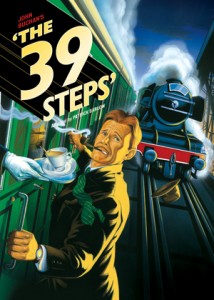
photo credit: Google Images
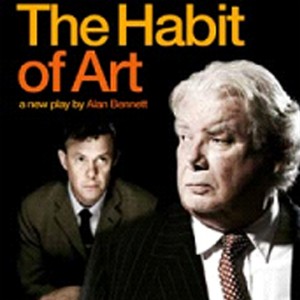
photo credit: Google Images
This is still just a theory. As a sidenote, I do think the framing had its merits. Caliban’s Day is about the pressure to create art, the artist’s consciousness of his role and reputation as an artist, and the contriving that goes on behind the scenes with the artist’s fear of biographical information seeping into or being read into his art. The insecure actors and writer and the ever-comforting and conciliatory stage manager are a parallel story to Auden’s and Britton’s, allowing the themes to be developed more deeply and thoroughly, applying them to theatre as well as poetry and music.
We have talked about theatre in London as being a sort of equalizer. Anyone who can afford even fifteen pounds can get a pretty good seat for a show. In the National Theatre, there are no restricted view seats nor are there any boxes. Everyone is on the same footing, and to demonstrate this, we got to sit in the same row as Sir Ian McKellen at The Habit of Art. While all of this is true, I still felt like a bit of an outsider at both of these shows. I really enjoyed The 39 Steps, but I still had some trouble catching all of the jokes, even after having read Fox and lived in London for a month. Many of the jokes, such as the jokes about Welsh politics and the “sorry, sorry, sorry” sequence on the train are distinctly British, and not fully accessible to us foreigners. The same held true with the humor in The Habit of Art. I’m not complaining; I’m sure American movies and plays present the same problems to the British. I do think I have a point though, in saying that the content in The Habit of Art was not accessible to just anyone. I think in order to fully understand the play, you needed a reasonable understanding of theatre and its operations (in this respect our backstage tour helped a lot) and an understanding of Auden’s biography, his poetry and The Tempest. It took me probably until close to intermission to grasp who all the characters were and the plotlines of both stories. I think the play was rather intellectual, despite containing much crude humor, and perhaps did not quite match the humble and universally accessible National Theatre.
Tags: 2010 Kaitlin
September 18th, 2010 · 1 Comment

All My Sons Poster for the Apollo Theatre
On Thursday evening I went to see Arthur Miller’s play All My Sons at the Apollo Theatre. Not to boast too much—I’m sure most people are tired of hearing about it—but three others and I purchased box seats in the theatre for only £10 each. We had to wake up early to queue for two hours in the bitter cold before the box office opened at 10am. It was definitely well worth feeling frozen for the rest of the day in order to see the play that evening.
I’m familiar with two of Arthur Miller’s other plays, Death of a Salesman and The Crucible, but knew nothing whatsoever about All My Sons. The play itself was very enjoyable—natural, uncomplicated lines presented by seemingly simple characters. Without examining the acting itself, the play’s deeper meanings and the presentation and development of them was brilliant. However, I’m no qualified theatre critic, so I’ll stick to sharing my reaction to the adaptation I saw.
The Apollo Theatre itself is a “Grade II listed West End Theatre, on Shaftesbury Avenue in the City of Westminster” and was built in 1901 (cited in above link). It’s a traditional theatre in that it has a large main stage with a cozy gallery of seats located on its ground floor, two upper balconies and side box seats. The audience for Thursday’s performance was mature. I would say most of the viewers were in their sixties. Us four Dickinsonians were definitely the youngest box seat ticket holders. The playwright Arthur Miller was, after all, very popular throughout the 1940s, ‘50s, and early ‘60s, so the maturity of the audience made sense.
In regards to where I sat in the theatre, the box felt like it was almost hovering over the stage. My view was somewhat restricted, but never before did I have the opportunity to see the actors’ facial expressions and gesticulations in such detail! Moreover, the setting—which included a real grass floor, an abundance of vegetation, and the front of a country house—could also be seen in great detail. Altogether, I was able to watch an incredible play and truly be a part of the scene.
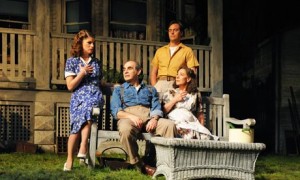
Main cast members of Arthur Miller’s Play
In All My Sons I was blown away by the two main actors’ performances. David Suchet’s reenactment of Joe and Zoë Wanamaker’s interpretation of Kate were absolutely extraordinary. For one, Suchet portrayed Joe’s sudden emotional changes flawlessly and with ease. One moment he could be furious, the mood convincingly illustrated in every corporeal and facial expression, and suddenly he would become vulnerable and distraught with tears streaming down his face. To me, the only negative aspects of the show were: the supporting cast’s American accents slipping at times (something I actually found amusing) and the set’s peculiar depiction of the Ohio countryside as looking more like the Louisiana bayou.
In the end though, All My Sons far exceeded the other theatre productions I’ve seen in London. Shakespeare’s Merry Wives of Windsor is still a favourite, especially since it was my first experience in the Globe Theatre. Bedlam, also in the Globe, was enjoyable only because of the jokes I shared with fellow classmates afterwards. I did love Les Misérables with its brilliant lighting, impressive set design, and Éponine’s angelic voice, but I wasn’t blown away by the performance (it did not help that my seat was in the uppermost balcony). 39 Steps was innovative and entertaining, but I found the slapstick humour dull after a while. The Habit of Art forced me to consider deeper, more intellectual ideas but was not the most well written play, I think. All in all, I have thoroughly enjoyed my theatre experience in London—although I would love to see some dance while I’m still here in England—and have appreciated every play and musical I have seen thus far.
If you haven’t see All My Sons yet, please do, and share your thoughts!
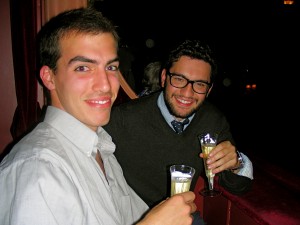
Patrick and Matt at the play All My Sons (personal photo)
Tags: 2010 Mary · Theatre
September 18th, 2010 · 2 Comments

Image from http://www.reelmovienews.com/gallery/gandalf-glows/ and also from the audience of “The Habit of Art”
In our short time in London, I have gotten the opportunity to see a large sampling of what London’s theatres have to offer. From standing in Globe Theatre to watch “The Merry Wives of Windsor” (or, shudder, “Bedlam”) to leaning right over the actors of “All my Sons” from a box seat, I must say I have been quite impressed. The low cost of London’s theatres is particularly amazing. I have yet to pay more than fifteen pounds for a ticket, including seeing two shows on the West End. Given my love of ranking things, I am going to discuss each show from my least to most favorite. After that, I will briefly discuss my observations concerning the differences between American and British theatre.
Worst: “Bedlam”
Wow. Truly, astonishingly, bad. To begin with, I find the Globe to be sort of a touristy gimmick. When inside the theatre, I feel less like I’m in the era of Shakespeare and more like I’m at the Renaissance Fair in Pennsylvania. This being said, a good production, like “The Merry Wives of Windsor,” can still happen in a sub-par venue. However, a good production Bedlam is not. The actors seemed talented enough, but they clearly not invested in the show. No one was having a particularly good time on stage, and no one took their performance to the next level. Quite frankly I do not know if this would have been possible, as the script was terrible. You know something is bad when the entire audience groans at the climax of the play (On a side note, the audience seemed noticeably less touristy than the crowd at “Merry Wives of Windsor,” likely due to unfamiliarity of the show)
5: “Merry Wives of Windsor”
Now the quality of shows jumps up exponentially. “Merry Wives” is a sub-par Shakespeare comedy, but it was performed with enough conviction to make it quite an entertaining evening. The plot is quite convoluted, and the running length is far too great, but it was fun. I must ask, though: Why does the Globe insist on musical numbers between scenes? Are they trying to REALLY make it feel like the Renaissance Fair?
4: “The Habit of Art”
First of all, the National Theatre is an incredible venue. All three theatres were so meticulously thought out that there was not a bad seat anywhere. Unfortunately, “The Habit of Art” doesn’t belong on such a gargantuan stage as the one in the Lyttelton Theatre. I found the show to be a great two man drama hidden within a convoluted play-within-a-play series of gimmicks. While I appreciate Luke’s point in an earlier blog that the show at least tried to achieve greatness, and hit on a lot of themes in interesting ways, I still think that the show was far too flawed to be considered a success. The saving grace was that the audience was very receptive to the inside theatre jokes, as it seemed to be compromised of experienced theatre goers…and Sir Ian McKellen.
3: “The 39 Steps”
As Luke points out, and I think quite accurately, “The 39 Steps” excels at its rather un-lofty goals. The show is simply meant to be pleasant, and that’s what it delivers to a much more casual audience than the National Theatre. I still rank it above “The Habit of Art” because it appealed to a whole lot of my interests. As a huge Hitchcock fan, it was fun to see all of the clever references. I enjoyed all of the puns, clever staging, and impressive comedic acting. Yes, it was about as deep as a puddle, and it was not funniest show I had ever seen. However, I enjoyed it quite a bit.
2: “Les Miserables”
This is my favorite musical, and while it was not the best production of it I have ever seen, it was still solid. I wrote another blog about the only difference I saw between this and U.S. versions of the show. Other than that, it felt like a Broadway production in what might have been a slightly smaller theatre.
Best: “All My Sons”
The box seats might have helped. However, this show was incredibly powerful and moving. Once you got over a couple hiccups in the American accents, the acting in the show was impeccable, particularly by the lead actor David Sachet. The theatre itself was very similar to that of “Les Mis” and “39 Steps.” We were about twenty years younger than everyone else in the audience, but it did not matter in the least. Incredible writing, mesmerizing acting and solid directing made this the best show I’ve seen in London.
In comparing London theatre to that of America, and in particular New York, I am reminded of Rick Fisher’s analogy of Hollywood(Broadway) versus Independent Theatre(West End). I don’t think the comparison truly works. In terms of on-Broadway shows versus the West End shows, both are almost entirely comprised of very commercial, un-risky ventures. The West End has “Wicked,” “Chicago,” and “The Lion King” like Broadway, and adds to it stage versions of Thriller and Queen songs. Certainly, there are more avant-garde and quirkier productions around London in the National Theatre and elsewhere, but those are directly comparable to the quirky productions you might find off-Broadway. In terms of the shows themselves, I personally don’t think there’s huge difference between London and NY. For the past twenty years, it seems as if the two cities have simply been swapping shows. Broadway will get “Les Mis” and “Billy Elliot” from the West End, and in exchange London will get “Wicked” and “Jersey Boys.” The difference is in the audience. Because tickets are so much cheaper in London, the shows are blessed with a much more theatre-literate audience. It raises the energy of the production and, from my experience, makes for a better show. In conclusion, cheap theatre tickets are awesome.
Tags: 2010 Andrew
September 9th, 2010 · 3 Comments
“Doctors, patients, poets, Christians and cannibals” are what the program for “Bedlam”, Nell Leyshon’s new play, promises. The first female-written play ever to be produced for Shakespeare’s Globe Theatre focuses on Bedlam Mad Hospital, an institution whose practices are drenched as much in sex, exploitation and alcohol as in science. Visionary? Maybe. Crazy? Absolutely.
The central plot revolves around Dr. Sidney Carew, a “mad doctor” who typically treats patients with a mixture of leeches, solitary confinement and contempt. It’s only when a new governor with some modern ideals comes to town that the doctor’s methods begin to be questioned. As Carew’s questionable sanity and alcoholism are brought to light, we begin to wonder if the “mad doctor” is, in fact, mad himself. All this time, we see a few separate plot threads take shape- one regarding May, a beautiful, crazed country girl apparently tipped into madness after the departure of her beloved “Billy”, and another detailing the strange pseudo-sexual rapport between Laurence, a self-proclaimed genius playwrite, and Gardenia, presumably his former mistress. Intriguing? It certainly should be, but what could (or should) have been a probing examination of sanity, sexuality, and ethics in medicine quickly devolves into a mismash of conflicting messages and mindless staging. What’s most disappointing, though, is the fact that not a single character or plot is developed to its potential.
Throughout the play we see a cast of colorful and crazy characters, many of them immediately interesting and compelling (a mad painter who’s violently obsessed with capturing the likeness of a beautiful but insane patient- what’s not to like?), parade vulgarly around the stage. Leyshon conceives these characters to inhabit her Bedlam Hospital but she seems to have stopped there- the only character in whom we see any sort of change or development is Dr. Carew as he tumbles further into madness. By the end of the play, May, the beautiful, insane patient, is still every bit as beautiful and every bit as insane. Laurence is still as self-infatuated as he is when we first see him. Billy is still naive. The governor is still an unbelievable Disney-inspired Prince Charming. The painter, from whose first scene I was excited about and attached to, is forgotten and unexplored. It’s as if Leyshon didn’t get the memo. She has a device (portraiture) through which to develop something really, truly poignant: at what point does physical beauty lose out to inward ugliness? can art drive someone to insanity? should obsession be followed or suppressed? There are so many routes that could’ve been taken here. Instead, the painter is dragged into a cell early in the second act and not heard from again. What a waste.
To make matters worse, the thematic concerns of the play are almost as muddled and confused as the staging (which isn’t helped by the fact that the lights at the Globe are permanently fixed). Leyshon’s primary motives are obvious- she wants to shed light on the humanity of the so-called “mad”, and on the inhumanity of how they are dealt with. It’s a perfectly noble aim. There’s even a point at which Tom O’Bedlam, a patient, gives a rather beautiful soliloquy pleading with the audience not to forget the man he once was.
The problem is, (warning- about to give away the ending) the laughable final scene in which a blindly infatuated Billy marries May, who is still hearing voices and talking to birds, thematically contradicts Tom’s speech entirely. There is absolutely no humanity in May. Her madness is even used as a device of humor during what should be the emotional climax of the play. “Let’s all laugh at the stupid crazy people” is not, I think, what Leyshon intended the lingering message of her play to be. But that’s what I came away from it with. I’ll give it this- the play had its funny moments. The rapport between Gardenia and Laurence was well-written. But I can’t forgive Bedlam for kicking to the curb the beautiful and complex paths it could’ve easily taken.
Tags: 2010 Patrick
September 7th, 2010 · 1 Comment
… So far.
During the two weeks in London, I have so far had the opportunity to see a variety of shows, which have offered different perspectives of theatre culture in England.
First, there was The Merry Wives of Windsor at The Globe. As a groundling after a long day exploring the city, my feet were exhausted by my excitement levels were through the sky (well, higher than usual, as they tend to be at somewhat extreme heights in general). Seeing Shakespeare performed at The Globe was an incredible experience for many reasons. Not only was the performance one of the best live productions that I have seen, the theatre’s atmosphere was almost indescribable. It was almost if everyone had traveled to the turn of the 17th century. Usually, everyone is quiet during the performance and politely respectful of the performers. While this was the case, the audience seemed more willing to shout, cheer, and laugh uncontrollably at the events on stage. Being so close to the stage, the magic of the actors radiated from the stage and created an atmosphere unmatched by any performance thus far. The added music also added to the atmosphere- an Early Modern theatrical experience would have had the pre-show performers and would have been completely different from what we are used to. The performance was as close to replicating that experience as possible in our modern world. Afterwards, we were able to thank some of the actors and they seemed sincerely grateful that we said something- an idea that would be challenged later.

Next came the Proms at Royal Albert Hall. While The Globe was magical, Proms was one of the most equalizing of the performances because of how accessible they were. In the States, every classical concert I have been to has been a stuffy affair. There, the celebration of the music was open and everyone seemed to be unified in their desire for good music (which the audience should not have been disappointed with). The biggest issue I had with the Proms was the incessant coughing. Usually people try to hold their coughs, but when one or two people cough at during movements, it doesn’t provide an excuse for everyone to cough uncontrollably to prove they can and that they are not going to do disrespect the musicians by coughing during the performance. I would like to go back to Proms to see if it is a bizarre tradition or if that night was a fluke.
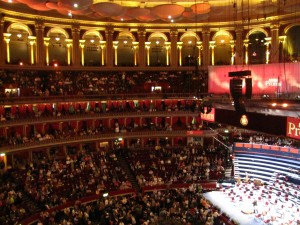
Royal Albert Hall
My following experience was Billy Elliot, which I have already blogged about, so I’ll try not to be redundant here. Other than being my first big West End experience, it was also important because it showed a lot of the themes of our course in a new light. Instead of applying the themes to the immigrant communities, it showed the themes in terms of a distinctively native English story. Furthermore, it also highlighted two differences between English and American theatre in particular. Firstly, we aren’t used to paying for our programs in the States. As an avid theatre goer, I’m used to being handed a Playbill (or regional equivalent) and continuing into the theatre. I don’t have to wonder who the cute guy playing a certain character is or why so and so looks so familiar. I don’t mind paying an extra three quid when I’m paying half of what I’m used to paying, but it definitely caught me off guard. Secondly, the tradition of stage door here is (as far as I’ve gathered) practically non-existent. In NYC, it is fairly common to wait after the show at the stage door to thank the actors for their performance, get an autograph, and if you are lucky, a photograph. (Yes, this can be a weird experience, but it can also be a great one.) When we went after Billy, it was completely different. While there were people there, the actors went by ignoring everyone. After Holly mentioned it, I realized that this was indeed a representation of the English concern for privacy and social dis-ease. On stage, the actors are free from interacting with the strangers feet away from them. At the door, they are in a different type of spotlight. Yet, the boundaries between personal and private life would not intersect. They are still technically at work. The guys from The Globe seemed to enjoy that we acknowledged them. I can’t wait to try another stage door experience to see the difference. (I planned to try again after Les Mis, but it was raining…)

The Victoria Palace, Home of Billy Elliot
Next came Bedlam, back at The Globe. For the first play by a woman performed there, the show was interesting. I’d like to say it succeeded it my expectations (which weren’t that high), but it didn’t. It did meet them, but something about the show was lacking the magic of the first show we saw there. At the end of the first act, I wasn’t at all satisfied, but by the end of the second, it had redeemed itself. I’d like to blame this all on not being a groundling and therefore surrounded by the audience members and the actors. I did enjoy it but it was not my favorite by any stretch.

The Globe, A View From Above
Lastly (thus far) is Les Miserables. One of my favorite musicals, I thoroughly enjoyed it. Despite the fact Marius has a slight bald patch, the actors were outstanding. (Even Norm Lewis, who I have seen in another musical and was THOROUGHLY disappointed in then, was outstanding. His awkward- but commanding- stage presence was perfect for Javert.) A truly equalizing musical, I was not surprised to see people in blue jeans and others in formal dresses. The difference is interesting when considered in the context of the musical and its equalizing themes. Theatre in London is truly for everyone- no matter one’s status. Seeing the opposites in dress at this show hit me as strangely appropriate. (I don’t want to elaborate knowing that some of you guys have yet to see it. So, I’ll just leave it at that.)
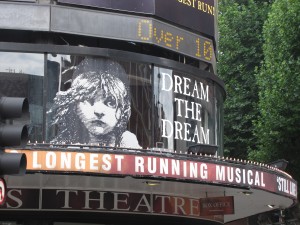
So far, I’ve thoroughly enjoyed my experiences at the theatre and can’t wait for more. I’m hoping to see Wicked (my favorite, in case you have missed that slight detail) and Blood Brothers at the very least. While technically not theatrical, I also expect my experiences at the various football matches I’m planning on going to to be worthy of a theatre stage!

Tags: 2010 Stephenie · Theatre















